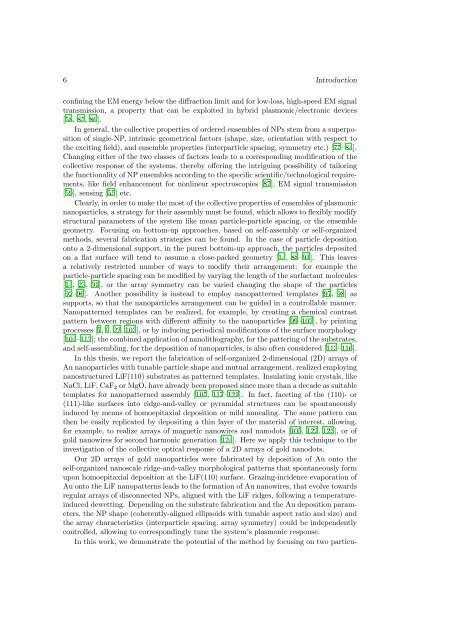Morphology and plasmonic properties of self-organized arrays of ...
Morphology and plasmonic properties of self-organized arrays of ...
Morphology and plasmonic properties of self-organized arrays of ...
You also want an ePaper? Increase the reach of your titles
YUMPU automatically turns print PDFs into web optimized ePapers that Google loves.
6 Introductionconfining the EM energy below the diffraction limit <strong>and</strong> for low-loss, high-speed EM signaltransmission, a property that can be exploited in hybrid <strong>plasmonic</strong>/electronic devices[58, 85, 86].In general, the collective <strong>properties</strong> <strong>of</strong> ordered ensembles <strong>of</strong> NPs stem from a superposition<strong>of</strong> single-NP, intrinsic geometrical factors (shape, size, orientation with respect tothe exciting field), <strong>and</strong> ensemble <strong>properties</strong> (interparticle spacing, symmetry etc.) [75–84].Changing either <strong>of</strong> the two classes <strong>of</strong> factors leads to a corresponding modification <strong>of</strong> thecollective response <strong>of</strong> the systems, thereby <strong>of</strong>fering the intriguing possibility <strong>of</strong> tailoringthe functionality <strong>of</strong> NP ensembles according to the specific scientific/technological requirements,like field enhancement for nonlinear spectroscopies [87], EM signal transmission[59], sensing [55] etc.Clearly, inordertomakethemost<strong>of</strong>thecollective<strong>properties</strong><strong>of</strong>ensembles<strong>of</strong><strong>plasmonic</strong>nanoparticles, a strategy for their assembly must be found, which allows to flexibly modifystructural parameters <strong>of</strong> the system like mean particle-particle spacing, or the ensemblegeometry. Focusing on bottom-up approaches, based on <strong>self</strong>-assembly or <strong>self</strong>-<strong>organized</strong>methods, several fabrication strategies can be found. In the case <strong>of</strong> particle depositiononto a 2-dimensional support, in the purest bottom-up approach, the particles depositedon a flat surface will tend to assume a close-packed geometry [14, 88–91]. This leavesa relatively restricted number <strong>of</strong> ways to modify their arrangement: for example theparticle-particle spacing can be modified by varying the length <strong>of</strong> the surfactant molecules[14, 23, 91], or the array symmetry can be varied changing the shape <strong>of</strong> the particles[92–96]. Another possibility is instead to employ nanopatterned templates [97, 98] assupports, so that the nanoparticles arrangement can be guided in a controllable manner.Nanopatterned templates can be realized, for example, by creating a chemical contrastpattern between regions with different affinity to the nanoparticles [99–102], by printingprocesses [7, 9, 22, 103], or by inducing periodical modifications <strong>of</strong> the surface morphology[104–112]; thecombinedapplication<strong>of</strong>nanolithography, forthepattering<strong>of</strong>thesubstrates,<strong>and</strong> <strong>self</strong>-assembling, for the deposition <strong>of</strong> nanoparticles, is also <strong>of</strong>ten considered [113–116].In this thesis, we report the fabrication <strong>of</strong> <strong>self</strong>-<strong>organized</strong> 2-dimensional (2D) <strong>arrays</strong> <strong>of</strong>Au nanoparticles with tunable particle shape <strong>and</strong> mutual arrangement, realized employingnanostructured LiF(110) substrates as patterned templates. Insulating ionic crystals, likeNaCl, LiF,CaF 2 orMgO,havealreadybeenproposedsincemorethanadecadeassuitabletemplates for nanopatterned assembly [105, 117–121]. In fact, faceting <strong>of</strong> the (110)- or(111)-like surfaces into ridge-<strong>and</strong>-valley or pyramidal structures can be spontaneouslyinduced by means <strong>of</strong> homoepitaxial deposition or mild annealing. The same pattern canthen be easily replicated by depositing a thin layer <strong>of</strong> the material <strong>of</strong> interest, allowing,for example, to realize <strong>arrays</strong> <strong>of</strong> magnetic nanowires <strong>and</strong> nanodots [105, 122, 123], or <strong>of</strong>gold nanowires for second harmonic generation [124]. Here we apply this technique to theinvestigation <strong>of</strong> the collective optical response <strong>of</strong> a 2D <strong>arrays</strong> <strong>of</strong> gold nanodots.Our 2D <strong>arrays</strong> <strong>of</strong> gold nanoparticles were fabricated by deposition <strong>of</strong> Au onto the<strong>self</strong>-<strong>organized</strong> nanoscale ridge-<strong>and</strong>-valley morphological patterns that spontaneously formupon homoepitaxial deposition at the LiF(110) surface. Grazing-incidence evaporation <strong>of</strong>Au onto the LiF nanopatterns leads to the formation <strong>of</strong> Au nanowires, that evolve towardsregular <strong>arrays</strong> <strong>of</strong> disconnected NPs, aligned with the LiF ridges, following a temperatureinduceddewetting. Depending on the substrate fabrication <strong>and</strong> the Au deposition parameters,the NP shape (coherently-aligned ellipsoids with tunable aspect ratio <strong>and</strong> size) <strong>and</strong>the array characteristics (interparticle spacing, array symmetry) could be independentlycontrolled, allowing to correspondingly tune the system’s <strong>plasmonic</strong> response.In this work, we demonstrate the potential <strong>of</strong> the method by focusing on two particu-
















